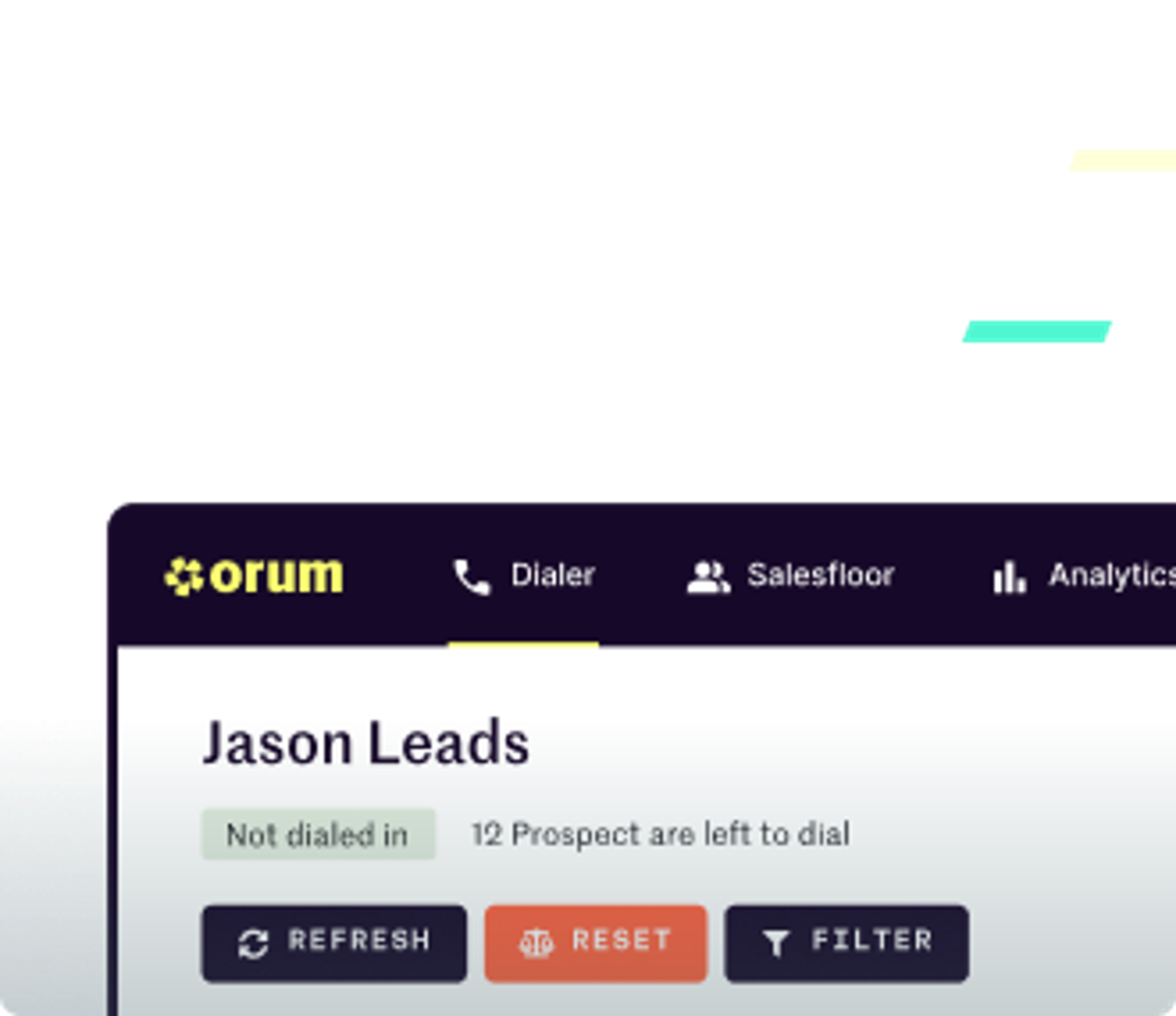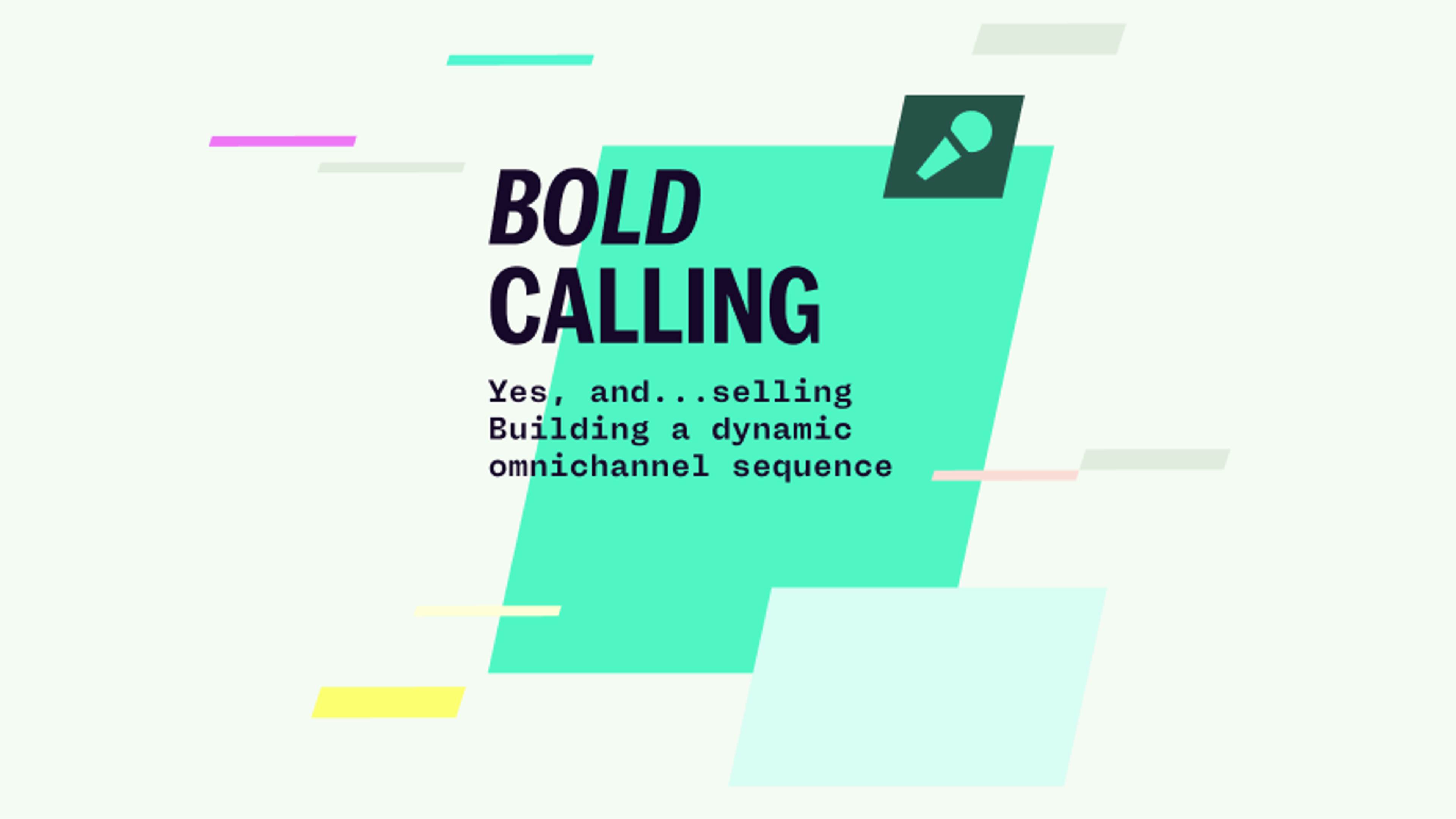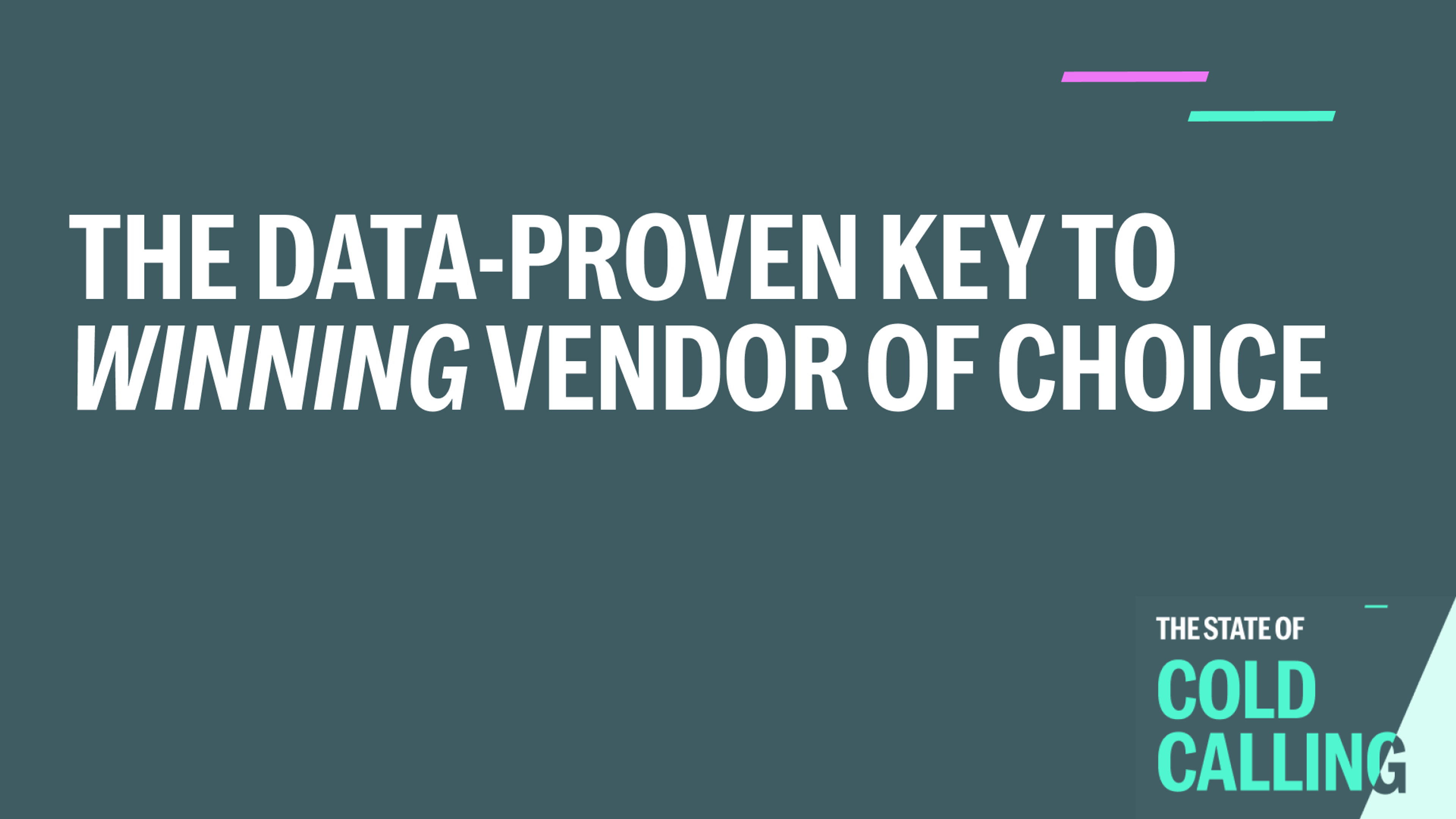Adam Sockel (00:01.302)
You're listening to Bold Calling, an award-winning podcast presented by Orem where every episode we're bringing on the biggest and brightest minds in the tech and sales industries for a discussion about their biggest challenges and the unique ways they're working to solve them. I'm extremely excited today because my guest is Colin Spector, the SVP of revenue here at Orem. Colin, thank you so much for joining me today.
Colin Specter (00:21.952)
Absolutely, Adam. Thanks so much for having me. It's a pleasure to be on the show. Obviously love bold calling, love Aurum. So looking forward to getting into it and sharing some insights with the audience.
Adam Sockel (00:35.426)
Yeah, so we are going to be talking about sales enablement today. And this is honestly a little bit selfish of me getting to bring you on to do this, because as the content person here, Orem, obviously you head up our revenue team. For me, this is almost like making sure that I'm doing the things I need to do, then benefiting all of our listeners by doing that. because of this, creating all the content that I do, I always have as a marketer, I always have this fear that it's just going out into the ether and no one's using it. No one's seeing it.
which is where Sales Enablement comes in. So I want to dive right in and ask you, as a leader from the sales side of things, the first thing I want to ask you is, when marketing is creating all of this stuff, in our minds, we're the center of the universe as marketers. We think our campaigns are incredible and everyone's minds are to be blown by this new video we roll out or this new t-shirt and then we can send it to salespeople.
In many cases, not here at Orem, but in many cases, salespeople just roll their eyes and they're like, okay, great, thanks so much. So the first thing I want to ask is when marketing people are creating things that we do want to provide for sales reps to actually use, what would you say like the formats and structures should be that we should be providing that content so that it's actually usable? And this could be like email snippets or one-pagers. Like what are the actual structures that a sales
leader and then a sales team would use when this content is created.
Colin Specter (02:08.974)
Yeah, it's a great question. So I think a couple thoughts there. One is meeting the reps where they already are is super helpful for adoption, right? And so if we're talking about just logistically, like where the content should live, I think...
You know what, what I, what I've seen, and I'm not saying this happens at Orem, but what I've seen just in general in my time is, you know, marketing might have some sort of content hub or some sort of other system that, they love to live out of. if, the, frontline sellers or field team are not, you know, used to going into that system or they, don't really go into that system for any other reason. it's not something that they're going to often check for like content updates and, know, and, things like that. ideally marketing and sales.
can be on the same like intranet and it's already a place that like both people live, whether it's like in specific Slack channels or Notion or specific shared drives. And there's a mutual understanding and shared understanding of like the language of where things are when they are described and the kind of organization structure of those things versus like learning an entirely new like content system versus like, you know, your sales enablement system.
you know, might be different. And so I think as long as like sales enablement and marketing, know, product marketing are on the same page in terms of the kind of learning framework, then it becomes easier to get the right adoption and kind of meet people where they are just more structurally there.
Adam Sockel (03:43.84)
Yeah, I love that. And for larger, very well established companies, they very well may have a tool like RevSpot and HighSpot, where it is a sales enablement tool where marketers can put stuff into a specific tool. And it says for all of the sellers, this is the part of the buyer's journey. You're going to need to use this, and here's exactly what to say. for companies of various sizes, and ours as well, you guys don't have that specific.
Like access, is it really just as simple as saying like, you said, like we're all living in Notion, let's just keep everything in there. Like it, or is there, you know, a better way for marketers to like develop a cadence and saying like, here is what's going on and we need to tell you this every single month. Like, is it just as simple as saying like, you guys live in Notion, we need to live in Notion too.
Colin Specter (04:36.578)
I would say like the best way to get adoption is versus, you know, trying to get the whole group to adopt at once, find a pilot rep or two with a new, a new asset or new talk track or new demo flow or new description of features, whatever it might be.
Like it helps, you know, like reps love reducing uncertainty because reps, you know, like reps get stuck in their ways, especially if they're doing, you know, well, they like have like a flow down. have certain assets they like to use. They're more resistant to change with like a new sales deck. Right. And like, you know, you often like have reps roll their eyes when there's like a new marketing deck, like every year, right. Especially like folks finally get dialed into a certain flow, a certain deck, certain types of assets. But, I think showing, showing examples of success.
And what good looks like with the new asset can, can definitely help with adoption. Yeah. So I don't think it's like, it's not just as simple as like, yeah, we all use Google drive and you know, I think more just that's like, let's reduce as many controllable hurdles as possible. And then, and then, you know, to spark adoption, like tap the rep that folks, you know, respect their opinion and their use of, of different, different decks and tools and so forth. So.
That's, that would be my advice there.
Adam Sockel (05:58.582)
Yeah, speaking of creating champions and finding, like you said, like pilot reps to adopt these pieces of content, I want to ask you, and this is kind of connected to our experience here at Orm. When I first started a little over two years ago now, we had a content debt. There wasn't really a content person. And so I remember when I first started, I came to you, I came to our other sales leaders, I came to our CS team, and I said, what do you need? Like, what exactly do you need? And I started creating.
you know, whether it was like our calling culture guide or decision criteria checklist, anything you guys needed. was like, absolutely. Tell me specifically what you want. And now we've gotten to a point two years later where we have a lot of content and some might say, create too much at times. There's almost, you can't do something with all of this. And like, what I want to ask you is like, is there a certain point that you would say as a sales leader, when you guys come to marketing, like, is there a process that you think about?
when it's like, hey, this enterprise rep needs one specific piece from product marketing, or they need a single sales one pager, but it's really only going to be used in this one situation. Like how can marketing and sales create an understanding where sometimes someone has to say no, because, you know, insert rep here is asking me for a piece of content that's going to take me a week to create. But in order to create that piece of content, I can't create something that the whole team is going to create. So how do you...
I guess the long-winded question is, how can marketing sales create a relationship where you can, salespeople can ask for things and understand they're not always going to get what they want. How do you create that relationship between the two teams where there's an understanding of, we're going to do what's best for the whole, sometimes at the detriment of a single rep?
Colin Specter (07:46.818)
Yeah. So I think it's less about the rep and more about the impact, the business impact, which you already nailed. Right. So, I would say it's the same exact thing with like feature requests, right? could be a marketing asset or feature requests. Very similar. Like what are the actual dollar impact? what's the dollar impact of, building a feature? Like, let's say we have a big enterprise whale of a customer. It's going to be a million dollar deal and they need a certain custom workflow built. Right. Like.
Okay. That's worth dedicating an engineer towards building and delivering to land that seven figure contract, right? That seven figure account and customer, um, versus yeah, like if it's, you know, I don't know, a 20 K 30 K account, um, and it's a custom thing for them, some sort of custom integration for them, probably, uh, not like, unless, unless we have evidence and data that there are multiple customers that that will benefit and how much that is like, yeah, you got to make informed
business decisions, like you can't go and kind of react to every rep, you know, from the sales rep perspective, the most important request is like the one in front of them, the customer, like they're, they're working with like in that moment. And so like, for them, it's like, this is the world, you know, and if you're an SMB rep and a mid market rep, like a $20,000, you know, account, a $50,000 account, like you're like, how can you not be prioritizing this? This is my quota. This is like such a big thing. And so.
Yeah. Taking a business lens perspective, right? It does come down to your most valuable customers. Like who is giving you the most dollars is going to get the most attention and most kind of care in terms of features and marketing assets. Right? That's just the reality of, business. Right. And so.
That, that, that mindset of like marketing can't say yes, product can't say yes to every single request, we'll weigh the impact. You know, for example, an enterprise customer asked us for a workflow diagram. I want to call yesterday. Like I was like, we like a workflow diagram specifically with Salesforce, which we have a great Salesforce integration. And I didn't easily find.
Colin Specter (09:50.682)
You know, an asset like this that like showed the like fields and kind of a flow chart between Salesforce and Orem specifically. And I'm like, well, you know, we service, I don't know, a thousand plus Salesforce customers. I think at this point, like, uh, it probably would be something that I will likely come up more often and is probably worth prioritizing to like deliver that type of asset. Right. But if it's, let's say a flow chart with, you know,
bullhorn or, or, you know, a long tail kind of CRM that's more niche or an industry we don't like focus on specifically, we focus more on Salesforce HubSpot CRMs, then we have to weigh like, okay, maybe the rep needs to go build that on their own, you know, and modify like one of our other assets. so that's just a train of thought, right? Business impact. I would look at the revenue dollars, the number of customers it impacts and can help whether it's a feature or marketing asset.
Adam Sockel (10:21.515)
Mm-hmm.
Adam Sockel (10:44.298)
Yeah, I love that. And for me, I'm a people pleaser. I'm a problem solver. get this from my mom. I constantly want to make sure I'm keeping everybody happy. And a lot of times, even when, like you said, one of our mid-market or SMB reps asks me for something, I'll go to another team before I say no and be like, would this be beneficial for you as well? Because to your point, if there's an enterprise company asking us for a very specific thing, it may seem very specific in the moment, but if it's an enterprise
company to land a big deal, whatever they're asking for is probably going to be beneficial down the line for another enterprise deal. it does make sense to do those things. yeah, my boss, Ting Ting, routinely is telling me, every time you say yes to something, you're saying no to other things passively, so just try to remember that. it's really wonderful to hear that from a sales leader saying, yeah, we just boil it down to ROI a lot of times, and that's a good way to approach it.
Colin Specter (11:41.316)
Yeah. Yeah.
Adam Sockel (11:43.706)
I want to ask you, do you in your mind have a cadence of how frequently we should be connecting as sales and marketing teams on sales enablement? Is it once a quarter, once a month? What do you think would be a good cadence for marketing to come to sales and say, hey, here's what's new, let's implement this into your process?
Colin Specter (12:05.722)
That's a good question. It probably comes up.
Maybe more structurally during a QBR, right? When we get the sales asks, right? Every quarter we, we get a summary of, what, what does the team need? Right. And that's where we're typically, we'll find patterns of, of, know, certain asset requests, right? That maybe we're missing or more, you know, feature enablement or sales sheets on certain features that we haven't yet developed. But yeah, I mean, stuff, stuff always comes up ad hoc, you know, of course, over those three months periods. Yeah. I think like more, maybe more formally once
a quarter we audit and take inventory. And then of course, in between that time, there's going to be some, we should always leave some capacity to handle, you know, the more impromptu kind of ad hoc requests that come up as a certain deals come up. And we recognize patterns of.
Things were missing, right? Like, you know, we just did a big like global launch. Like we, sometimes you don't know what you don't know until you run into it and people are like, well, can you give me like a guide for these like new European countries we support? Right? Like what, what, like how does the language modeling work there and all of that? Right? So like, we sometimes like, like you're right. We probably should build that. we didn't, know, but you don't, you can't like think exhaustively, you know, the first kind of release of things. So action brings information, right? So as we're.
Adam Sockel (13:22.901)
Mm-hmm.
Colin Specter (13:28.742)
Taking action in the marketplace. We're to get feedback and information about what what we need. And so I think Like yeah, just let's put a bow on it. Let's do it. Let's do a quarterly More formal sit down of like what do we need to build what we should prioritize but then keep capacity with one another to part, you know prioritize things as they come up and more of a maybe two-week sprint, you know basis like what product I feel like if marketing and products kind of mirror
you know, one another in terms of like research and development will be in good spot. So.
Adam Sockel (14:02.048)
Yeah, and especially the unsung hero in that is product marketers. You've got great product marketers here. if it's not on that same sprint, what's inevitably going to happen is product is going to tell us about a really cool new feature. And of course, the first question from salespeople are going to be, A, when is this available? And then B, how can I tell this to the world? So yeah, if.
sale, if product marketing isn't on the same page with product, I'm like, when the releases are getting rolled out, they're gonna have egg on their face when the sellers are like, okay, do we have one-sheeters? Do we have a video about this? Do we have snippets? Like, what can I use? So I absolutely love, yeah, I love that so much. like, we don't wanna be as marketers. We don't wanna be learning about product releases in real time with the salespeople, because then we're like, no, we're in trouble here.
Colin Specter (14:41.05)
100%.
Colin Specter (14:52.888)
Yeah. We like a demo flow and even better if we have like an actual like product video, can go like, you know, celebrate like shout out on LinkedIn about, like show like what it like we've got live transfer coming out, right? By the way, and I'm sure by the time this episode releases, it'll be live. Right. And so now I'm like, okay, we need to some assets around this. Like what's like a great workflow we want to pitch and everything around this, this new feature. So.
Adam Sockel (15:06.326)
Mm-hmm.
Adam Sockel (15:14.506)
Yeah, I will say something I do as a marketing person. My job is a little bit easier here at Orem because we are selling a sales tool. So I can go to our sellers and basically say, OK, you're the person being pitched Orem. What questions do you have? And then we can create content around that. But if your ICP is finance or DevOps, go to those people and say, we have this thing coming out. What questions would you have so that you can kind of, to your point,
When we have a thing that comes out, like you said, our international expansion, now it's 160 plus territories. There's going to be questions we don't think about. If someone's going to say, hey, I have a prospect in, I don't know, Manila or wherever, we're not going to be able to be exhausted with that. So it's always good to just ask, what is your ICP internally for those types of questions?
Colin Specter (16:04.505)
Yeah, I'm...
You know, ideally you have, and if you don't already, you should form a customer advisory board, right? And so with your ICP, right? Yeah. I mean, we, drink our own champagne so we can use our own internal. We are our own internal customer, but that's not always the case with, with many companies. So yeah, you can either talk to your internal persona, like the person that works at your business or even better, you should form a customer advisory board with your, your ideal customers, your top customers, and let them be that first kind of feedback soundboard, give them some
Adam Sockel (16:18.422)
Mm-hmm.
Colin Specter (16:35.308)
equity and you know have them feel really a part of the journey.
Adam Sockel (16:41.366)
How can sales leaders develop accountability with the sellers? Again, I have a wonderful relationship with our sales team, we're recording this at very end of January. In fact, you're being very gracious with your time a week before the end of our fiscal year. I know if I release any content and I put it in Slack and Notion and all the places, it's going to fall on deaf ears this particular week. That's just the nature of business.
How can, you know, there's only so many times I can be like, Oram's big hype man and talk about how great this content is before people are like, all right, Adam, we get it. How can sales leaders develop accountability for their sellers to ensure that they are using all of the assets that are available?
Colin Specter (17:23.962)
Look, I think, uh, repetition is the mother of learning and, the job of the sales leader is communication and over communicate and you need to communicate to a point where folks are tired of hearing, like you want them rolling their eyes. Like, Oh, here you go. Here's calling again. Like saying, got a.
Use this talk track or here's calling again. I got to use the first call deck and I need to use this customer slide. And, and so like, yeah, like I want to be annoying with, with my people. And as a leader, you have to be in, look, we're a remote company. don't get to put posters up around the office, like with the objective in the mission statement. like, have to, like, we have to repeat it over and over and over again, whenever we're in a sales floor or zoom call or, or what have you on Slack. Right? So we have to be over.
like intentionally over communicative especially because we're remote but it goes you know even within office stuff.
Adam Sockel (18:18.528)
Yeah, I love that. like for us, like you said, it's being over communicative is so important because we have, know, or as a virtual sales floor and like we as marketers jump on there. listen to our SDRs all the time, like ripping cold calls and like understanding what our ICP sounds like. But that, you know, that is one thing where like you can hear other people talk a certain way and be like, I'm going to try that. But the unseen things is the LinkedIn messages that they're sending or the emails that they're using and the different cadences and like.
that stuff to your point. It is something I've gotten good at is like over communicating to the point where I'm just like, yeah, someone's probably gonna roll their eyes at the things that I'm saying, but it'll help a few people and if it helps a few, it's a kind of like a groundswell. Yeah, absolutely.
Colin Specter (18:58.542)
Good.
It's not, it's believe me, you want to over communicate that under communicate. And then all of a sudden scratch your head. Wait, how come they said that? Or how come they didn't know the answer to this? And how come they didn't know we had that? Right? So over, over communication, always err on over communication for sure.
Adam Sockel (19:14.708)
Mm-hmm. Yeah, want to, I got two more questions for you. One, do you have a fine, I'm prepping on this ahead of time, so I apologize, but do you have a personal, like, preferred best practice for how to, how sellers can make requests from a sales enablement standpoint? would it be a Google Doc? Or I guess it's like, what way would you prefer, like, do you think would be the most efficient way for people that are listening in and just trying to set up sales enablement?
Colin Specter (19:41.07)
Yeah.
I think we're getting a good habit using the new Slack workflows feature, right? And I'm like, we do it in a rev ops channel. We're doing it in a product feedback channel. think, if we don't have it already, we should add a kind of marketing asset workflow. just cause again, like kind of meeting people where they are and the structures that they're already used to like engaging with. I think that's, you know, kind of stay consistent, right? Between the most common teams that are most.
you know, often getting requests. think if we teach one system, let's try and speak that same language and make it easier for folks to know, Hey, I know I'm going to go submit a request workflow for this asset, right? I think we just set it up for swag as an example, which is great. So yeah, we do it for swag. We do it for features, do it for rev ops changes. Let's also do it for, for, uh, marketing assets where it makes sense.
Adam Sockel (20:36.288)
Yeah, I love that. Yeah, if you're a person listening in and you guys use Slack and you're not using the Slack workflows, they are awesome. I am obsessed with not only just being able to request specific things, like you said, for swag, it's wonderful to see the reasoning too. Because a lot of times someone will just go into a Slack channel and be like, do we have this thing? I would like it. But with the workflows, you have to put, what is this for? What is the business purpose? Yeah, it's great.
Colin Specter (20:59.022)
Yeah. Well, to the point we made before you can even, we can, you can even ask like, what's the ARR potential that this asset will help or like what customer profile is this asset for? it's for all customers in Salesforce or, it's this one mega deal that is like a very niche thing I need built for security, right? Or whatever it is.
Adam Sockel (21:06.689)
Mm-hmm.
Adam Sockel (21:18.454)
Yeah, love that. how can people listening in ensure that it's also a two-way street that like, yes, sales is getting everything they need from marketing, but then, you know, our biggest thing as marketers is always when we're rolling out these campaigns or reports, how can we make sure that it's a two-way street so that sales are, you know, using their networks to properly amplify marketing messaging as well?
Colin Specter (21:43.938)
I think that's a great question. And I've been wanting to do more of this. think it happens naturally, but because, you know, we set, we set the example, we lead from the front as a leader. So if your people see you out, amplify the marketing message and on LinkedIn and Twitter, and they see you amplifying, then people will follow and see, okay, that's what good looks like. That's the prototype, but.
Also, think putting more intention behind it and train people and really like invigorate and empower people to go and do their own amplification is also important because not everybody naturally rises up to the occasion. Like, all right, well, Colin's posting and Adam's posting. should, I should go start posting. Some people do, and some people do it better than others. so I think, yeah, doing, doing like specific training and enablement on what good looks like and how to ideate.
and, and, starts a, what channels should you be posting? What type of content should you, and how should you structure posts and, and all of that? I mean, it's a great reminder. Like I've been wanting to do a training internally and like reinvigorate, that, that motion for us. So.
Adam Sockel (22:53.174)
Yeah, I will say, I will leave us with a, there's a quote from Remember the Titans, it's attitude reflects leadership. And I will say, I'm not just saying this because you're on with me, Colin is such an advocate for all the content and marketing channels that we have and all the different campaigns. if anyone is on LinkedIn and knows Oram, they also know who you are because you are such a big champion for that. I wanted to have you on and talk about sales enablement.
because I know it's something you believe in and the marketing and sales relationship. So one last question before I let you go. If people are just like starting the sales and implement journey, you know, what's like the first thing you would do? What is like the first thing that could kind of get people on the path? Like if they take one thing away from this conversation, what's the first thing they should do?
Colin Specter (23:39.994)
I mean, if you're just getting into it, you should do the listening tour or talk with the top, you know, the top people, the top leaders. And is there a pattern in what people need? And that's a great place to start, right? Triage, triage there, focus on, you know, after that, like the next level is let's look like you want to make impact to certain metrics. And so try to identify the behavioral metrics that.
You want to impact. behavioral metric might be, or, like the metric is a result of certain behaviors. Right? So when I say behavioral metric, that's what I mean. Like, like connect rate would be the behavior of making calls to the right people. connect to meeting rate would be the behavior of, I good at talking and booking a meeting? Is my message relevant to that person? Once I get them on the phone, my win rate is the behavior of how I run deals and how many I close versus the ones I speak with.
So identify the behavioral metrics that need the most help, that have big variance between people. And if there's someone that's way better than the group, deconstructing what they're doing different and put the blueprint...
of what they're doing differently to share with the others and is another great place to start. So I'd say after do the listening tour, focus and triage with what people need immediately and then be proactive in identifying the behavioral metrics that you can impact next.
Adam Sockel (25:07.039)
That's a perfect starting point. Colin, you have been very gracious at the end of our fiscal. Thank you so much for joining me today.
Colin Specter (25:13.834)
Adam, thank you. You know, what you said about amplifying the ORAM voice and everything is right back at you. I'm so thankful for our partnership here and look forward to continuing to amplify and make it all happen.
Work
💡 Ever feel like your sales enablement content is just floating in the void? You create incredible assets—one-pagers, sales decks, call scripts—only to have them collect digital dust. Meanwhile, your sales team keeps asking for more, or worse, they don't even know what already exists.
If this sounds familiar, you’re not alone. Sales enablement can be one of the biggest friction points between sales and marketing teams. But what if there was a way to actually get sales to use the content you create?
That’s exactly what we tackled in the latest episode of Bold Calling, featuring Colin Specter, SVP of Revenue at Orum. Colin joins host Adam Sockel for a no-BS conversation on how to bridge the gap between sales and marketing, drive adoption, and make enablement a true revenue driver.
🔥 The Biggest Sales Enablement Struggles (and How to Solve Them)
🚀 1. "Why Aren’t Reps Using This?"
Marketing teams often assume that because they created a killer sales deck or new email template, the reps will automatically use it. Reality check: that’s not how it works.
📢 What Colin says:
"Reps love reducing uncertainty. They have a flow they’re comfortable with. If you just drop a new deck in Slack and expect them to adopt it, you’ll get eye rolls."
✅ The Fix: Meet reps where they already are—whether that’s Slack, Notion, or a shared drive. And instead of rolling out a new asset to the whole team, start with a pilot rep that others respect. If they use it and win with it, the rest of the team will follow.
🔥 2. "Marketing Can’t Say Yes to Everything"
If you’re in marketing, you know the drill—every rep wants a hyper-specific one-pager tailored to their deal. But if you say yes to everything, you’ll never get the high-impact projects done.
📢 What Adam says:
"Every time you say yes to something, you’re saying no to something else. Prioritization is key."
✅ The Fix: When evaluating enablement requests, tie them to business impact:
- How many deals will this help close?
- Is it just for one rep or the whole team?
- What’s the revenue impact?
As Colin puts it:
"If an enterprise customer asks for a workflow diagram and we have hundreds of Salesforce customers who could benefit from it, that’s an easy yes. But if it’s for a niche CRM with only one deal attached? Probably not worth the time."
🔄 3. Making Enablement a Two-Way Street
Sales enablement isn’t just about marketing serving sales—it should be a feedback loop. The best sales teams don’t just consume enablement content; they help amplify marketing efforts, too.
📢 What Colin says:
"Sales leaders set the tone. If your team sees you posting and amplifying content, they’ll follow. But you can’t assume people will do it naturally—you have to train them on what good looks like."
✅ The Fix: Sales and marketing should work together on a cadence for content sharing. Whether it’s new product updates, playbooks, or outbound messaging frameworks, reps need to be part of the distribution process, not just the audience.
📌 Key Takeaways from This Episode
✔️ Start with a listening tour – Talk to your top reps and sales leaders to identify what they actually need.
✔️ Prioritize high-impact assets – Focus on content that will move the needle for multiple deals, not just one-off requests.
✔️ Use a pilot approach – Find a champion rep to test new materials before rolling them out to everyone.
✔️ Over-communicate – Repetition is the mother of learning. If reps aren’t tired of hearing about it, you’re not saying it enough.
✔️ Create a structured request process – Use Slack workflows or structured forms to ensure every enablement request is tied to revenue impact.
✔️ Make it a two-way street – Sales should amplify marketing campaigns just as much as marketing supports sales efforts.





